- The Konokai group brings together leading artist from different schools of Nihon Buyo (traditional Japanese dance, including the Ichiyama school, the Izumi school, Saruwaka school, Nishikawa school, Hanayagi school, Fujima school and the Wakayagi school. Could we begin by asking you to tell us how the group came to be formed?
- We formed the Konokai in December of 1999. Among the artists of the younger generation like myself, there was a fear that Nihon Buyo had gotten a image of being too formal and refined that was causing a loss in its popularity. We feared that it was becoming inaccessible to most people for a number of reasons. For example, even if you wanted to see a famous professional dancer perform, it is not easy to get information about performances. Or, even if people wanted to study traditional dance they might have fears that the lesson fees were very expensive or that there are a lot of intricate traditions involved. We had a fear that the Nihon Buyo tradition would not be carried on much longer. And, since there is only so much that one person can do alone, we decided that we had to band together as a generation of traditional dance artists and try to do something.
- Each of the schools of Nihon Buyo has its own unique forms and techniques that are called kata . I have heard that in order to protect and carry on those unique aspects, there is a sort of rule in the Nihon Buyo world that you should never take lessons from anyone but your own school’s master and that you shouldn’t interact with artists of other schools. So, wasn’t it difficult to start a group with members from other schools?
-
In the past it was true, not only in Nihon Buyo but in other traditional arts like Kendo (sword art) for example, where there was a time when they said that you shouldn’t even watch the lessons at any other school’s
dojo
(practice gym). But, knowing that you can’t remain that way like an ostrich with its head in the stand in today’s world, there were people who had begun to hold performances together with artists of other schools and arrange opportunities for artists from the different schools to meet and interact. Thanks to that trend I had been friends with young people my age from other schools since childhood and was meeting and doing things with them actively. Through that interaction I knew that I was not the only one who feared for the future of Nihon Buyo. We thought that there were things that one person couldn’t do but might be possible if we worked together. We were all in our 20s or early 30s and our youthful energy helped us make the leap to form Konokai. We chose the name Konokai (meaning the “group of
Ko
”) in hopes that many “individuals” (
ko
) will come together to form a large circle.
Our wish was to show the beauty and the art of Nihon Buyo to many of the children who be tomorrow’s society and also to as many adults as possible. We started our activities as a group with the desire to show that Japan has a wonderful art of dance with this kind of beauty, and even if people didn’t dance themselves, we wanted them as Japanese to know more about this art and come to see it. We wanted to work together to communicate this through programs that were easy to put together and easily accessible to the audience. - How did your twelve members come together?
- All of us grew up in families leading schools of Nihon Buyo and we are all the heirs of these families who will eventually inherit the positions of master of our separate schools, so we all grew up in the same type of environment since childhood. Also, being of the same generation and have long known each other through events like large Nihon Buyo events. One time, when master Kinosuke Nishikawa, the father of one of our members, Daiki Nishikawa, organized an event at Tennozu Isle Art Sphere (present Ginga Theater) for performances of classic ballet, modern dance and Nihon Buyo, I was able to perform in a group dance work that he had choreographed. Performances of that work continued for several years, with perhaps seven dancers of our generation performing one year and ten the next. Then at one point master Nishikawa said to us that as long as we were getting together to perform like this, it would be good if we started working together doing other things as well. That turned out to be a big impetus that led us to form our group to do something for the future of Nihon Buyo.
- So, what brought you together was that need you all felt to do something for the future of Nihon Buyo, wasn’t it?
-
That’s right. Since we had all been thinking on our own already about the need to do something for the future, when we formed Konokai we made it an opportunity to get together more often than our parents’ generation had and talk over drinks about things like the current status of Nihon Buyo.
Nihon Buyo is a dance art with a unique artistic aesthetic and beauty that has been nurtured over a long period. It is an art that contains many elements, such as the timing and pauses, customs and habits rooted in our daily life actions and numerous types of unique movements and gestures. For example, when we reach for something on a table, we automatically hold the right sleeve of the kimono with the left hand so it won’t touch anything on the table that might get it wet or something. In the dance this gesture becomes a beautiful choreographic element. It becomes a [dance] movement. However, movements like polling a boat with a [bamboo] pole of smoking tobacco with an old type kiseru pipe are things that people don’t understand anymore today. Because people don’t pole boats anymore. If you have the movement symbolizing smoking with the kiseru pipe in a dance, the audience doesn’t know what the dancer is doing. Long ago it was a movement commonly seen in daily life, but now it has reached the point where the audience watching Nihon Buyo won’t know the meaning unless they make a special effort to learn about it.
In Konokai we talk about this kind of circumstance and what we should do to keep Nihon Buyo alive for the future. We want our dance to be something that will look cool to children and young people even if they don’t know why; to have them feel that it is great the way it moves with the music and that it is fun to watch. It will be good in our minds if people are inspired watching the fruits of our efforts as artists to the point where they will want to come back and again to watch Nihon Buyo seriously. We realized that Konokai could serve an important role by providing that kind of initial entry experience. - As you grew up in Nihon Buyo family, you also had surely never someone poling a boat or smoking with a kiseru pipe just like children today. When you were taught those movements, didn’t you feel they were strange?
-
Of course I did. And that is the importance of handing along a tradition from generation to generation. These things have to be learned through physical practice, not simply as a matter of knowledge. In sure this is the same in the world of
Ikebana
flower arrangement or the tea ceremony or judo or karate. Simply knowing that in the old days people poled boats or smoke with a
kiseru
pipe doesn’t mean that you can do the movement. Mastering the movement requires repeated contact and practice between the teaching master and the learning apprentice. It requires patience on the parts of both the master and the apprentice, and they must spend time at it. That is the way that true succession of an art takes place from generation to generation.
My father is one who inherited the position of master of the Ichiyama school before he was really aware of the full significance of the position. It was until seven or eight years later when his own daughter became old enough to be training for stage performance and began asking him questions that he realized that now he was the one in the position where he had to pass on to his daughter the things that he had learned from his father and master and felt the true weight of the succession. When you have truly absorbed the essence of the dance and it becomes part of your body, it becomes a “language” that flows naturally from the heart and from the body. If the tradition is learned properly, dance is a language spoken by the body. And, I believe that in that sense Nihon Buyo is a universal language. - From what age did your dance training begin?
-
My first stage performance was when I was two years and seven months old, and it was at the Shimbashi Enbujo theater in Tokyo. Everyone said I did great, but in fact I was of course being made to do it as the eventual heir of the Ichiyama school. My first lessons probably began when I was about one year and seven months old. All I remember from those early years was when I was being scolded. We now live in an era when physical punishment is prohibited, but in the world of performance arts I believe a good amount of strictness is necessary [at a young age]. It is when you are scolded that you first realize what you are supposed to do. Before my father, it was my grandmother that was master of the Ichiyama school, and both of them were very strict with me [in my training].
There were times when I didn’t like being pushed along the course that had been set for me [by birth], but when I reached the point where I realized that I loved dance, I was grateful for all they had put me through. It was after graduating from high school that I found I really loved dance. By that time I was a member of the Nihon Buyo Association and in the course of trying to do my best to learn a piece I had been told to memorize by the next day or to choreograph a certain part for a performance, I naturally came to love it. - In the past, many children were taught Nihon Buyo in order to give them a graceful bearing and etiquette, but that isn’t as true today, is it?
-
Unfortunately, it is true that the number of children learning Nihon Buyo has decreased. There are no children who will say at the age of five or six that they want to learn Nihon Buyo, so it is the parents or grandparents that bring them lessons in concern for their futures. It is probably a trend of the times but, while parents will want to give their children piano lessons or send them to cram school, there are now few who think of Nihon Buyo as something to have their children learn. It is certainly nice if there is a flower arrangement on the dinner table, but it is not a necessity that people can’t live without. And, that is the same with Nihon Buyo today. That is the biggest problem.
However, in today’s globalizing world, I think that those who are recognized by others are the ones who first of all know your own country’s culture. That is why I want to go to as many places as I can to communicate with children, not to tell them that they should learn traditional dance but to give them a chance to see it, if only once. - Since you founded Konokai, you have continued to work together to present new works for a group of male dancers, and performed in the suodori (no special role costumes or hairpiece) wearing the formal montsuki-hakama (formal kimono with a family crest and separate skirt) outfit.
-
The
montsuki-hakama
is the formal wear of Nihon Buyo; it is our uniform so to speak. And, if we perform in the
suodori
style we don’t need to wear any special costumes, so it is possible to dance any type of piece that way. By simply changing the movements, it can become any type of dance [for any role]. In Konokai, our policy is to not use any props either, and since it is
suodori
performance, everything must be expressed solely with our body.
As for the idea of creating and presenting specifically new works, I feel that is only natural. Because the established works that are normally performed in Nihon Buyo as the “classics” were once new works as well. Creating new works is not something that is unique to Konokai. All Nihon Buyo artists are constantly creating new pieces, but after they are performed at the artist’s recital, that is the end of them. Part of the reason that very few of these new works are ever performed again is that our recitals are mainly performances of the classics, such as Fuji Musume (Wisteria Maiden), Echigo Jishi (Lion of Echigo), Tomoyakko (mistress Yakko) and Dojo-ji (Dojo Temple), but at Konokai our intention is to keep trying to create new works that may some day be passed on to the next generation and in that way become known as classics. - I saw your work Onbashira that premiered in 2000 and has been re-performed numerous times since then. It is a work that impressed me very much with its dynamism and new performing elements that are different from classic Nihon Buyo until now. This is a work based on the Onbashira Festival that is held once every six years in Suwa Taisha (Suwa Grand Shrine) in Nagano Prefecture. The festival involves cutting down and hauling the “onbashira” (honored pillars) to be raised at four corners in front of and behind the Suwa Grand Shrine as residences for the gods of the shrine. The climax of the festival is the Kiotoshi (dropping the tree) where a large group of men slide the giant pillar down a steep slope at the base of the mountain where they are cut down. In your dance work Onbashira you have worked the actions of cutting down the tree, sliding it down the slope and raising the pillar, magnificently into a group dance.
-
In creating
Onbashira
we began by imagining how we could give expression to the heroic act of sliding the huge tree trunk down the steep slope (
Kiotoshi
) as dance. The most important thing was communicating the drama of the Onbashira Festival. It is not enough just to dance beautifully. There must be something that moves the viewer. You could call it the narrative element. We gave importance to the story involved. It would be easy just to tell it in a narrative, but we have to show it in the form of a dance, so in order to communicate the story to the audience, we have to use convincing movement. Inventing that movement is where the art is involved. It may sound difficult but communicating through physical movement and gestures is basic to the human race. In any country in the world, people understand the physical gestures that say, “Come here,” or “I love you,” or “Give me that.” Since we are dance artists we invent ways to give beauty to those gestures. In creating a new work, our members are all careful not to depart from the traditional techniques of our art, but in order to move the audience and inspire them, there is a need to depart from tradition at times. The montsuki-hakama we wear is formal attire, so it is not proper for us to be turning upside-down or rolling around on the stage floor. In Nihon Buyo there are masters who say that you should never use your voice in a dance. Others say you should not stick your fan in the sash behind your back and other things like that, but in our work Onbashira we broke several of these taboos. To express the felling of the tree, a dancer falls down and rolls about twice along the stage floor, and there are times when we roll back our sleeves and shout, “Uoo….” As we were choreographing these scenes we would discuss each part among ourselves, saying things like, “such-and-such a master won’t like it, but should we do it anyway?” (Laughs) But, since we did the choreography carefully, one step at a time based on our judgments as artists who have mastered the traditional techniques of our art, there are no unacceptable departures in it. But, if you don’t overstep the boundaries sometimes, nothing new will be born.Our Konokai members come from seven different schools of Nihon Buyo and we all discuss each part of the choreography together in depth when we are creating a new work. For example, it may take us three days to choreograph a one-minute section of a 20-minute dance. All of us can choreograph one minute worth of a dance very quickly, but when we [now] have 12 members from different schools, we get differing opinions from all 12 members. Members will be saying, “I think this is how it should go,” and then someone adds, “No, that’s not right,” and an argument develops in which one element is removed and then another and then a third, and then the remaining choreography is changed again. It quite often ends up going on into the early hours of the morning. Since this process exposes us to viewpoints from different schools, it is interesting, but it ends up taking us days to choreograph one minute of a piece. But because it is a process that takes into account the opinions of 12 different artists, it produces dance that on single one of us could have produced, and that constantly surprises us. We can never foresee the finished form, and it is a constant process of trial and error, but we are determined to keep running as long as we can and give as many performances as we can to as large an audience as possible.
- In this work, did you directly use impressions you got from actually going to Suwa and witnessing the Onbashira Festival?
- Yes, we went to Suwa to see the Onbashira Festival and talk with the local people involved. There is a dance called Otou Matsuri that is based on the Fire Festival of the city of Shingu in Wakayama Prefecture, and it came to be included in the festival performed in white [samurai] ceremonial kimono.
- The Otou Festival is a festival for the coming of spring that is held each year on February 6th at the Kamikura Shrine, a shrine to the spirit of a great boulder at the top of the mountain, isn’t it? In the festival, over 2,000 men carrying torches dash down the shrine’s steep 538-step stone steps.
- Four of us from Konokai went to see the festival. When the doors of the big gate in the shrine grounds are thrown open, everyone runs down the steps all at once. They are steep steps and the men have to run down with just the moonlight to guide them, so they have several ambulances waiting at the bottom to carry off the inevitable injured. It is a very dangerous festival. We ran down with them and got burns from the flying cinders of the torches, but there was a lot we learned from being in the festival. When you start out shivering in the cold and then experience the heat of the torches as you run down the steps, I truly felt an experience of having the spirit die once and then be reborn. That is the experience that we made into a dance. Said poetically, it was something that I had to experience in order to truly be moved by it. Since our work Otou Matsuri was created on commission from the city of Shingu and the premiere performance was held there, we knew we could not move the audience with something that was just superficially beautiful as dance. After the performance, we were told by customers at a pub we stopped in and by other people we met that they had been deeply moved by the performance. That was a very gratifying thing to hear and made me feel that we had succeeded.
- For artists who are charged with the work of carrying on a tradition, it must take a lot of courage to break out of the traditional forms and conventions.
- Yes, it does. We are very much aware of our responsibility to carry on and preserve the traditional techniques and the things we have been taught. But, we are now living in a different age. The audience is people of today’s society. If we rely only on the methods and techniques of the past, our dance will fall behind the times. In Konokai we have all worked together, making each decision carefully in order to create works for the present-day audience to see. We jump around until the hems of our hakama [skirts] turn inside-out, and we have done a lot of things that we are told are wrong by the masters of the older generation. In our work Onbashira we try to dance with the full conviction as if we are among the men who risk their lives in the festival by riding the huge tree trunk down the slope, falling off and drawing the courage to get up and hop back on it. This isn’t something that can be done with refined calm. Our final decision was to choreograph a piece that would probably cause spontaneous, boisterous excitement. This was a decision that no one of us could have made alone, I believe. That’s why I feel that forming Konokai was a great thing to do.
- How does the older generation of the Nihon Buyo world view Konokai’s activities?
- We have been told a lot of things by a variety of people, but we have also been complemented on Onbashira with words saying that we created a good work. I think they feel that it is something new that has never been done before in our tradition. The dance critics have also praised it, as seen by the fact that it won year 2000’s Dance Critics Association’s New Artist Award. In the justification for the winner choice, the critic Takae Saegusa cited the long standing ovation that followed the performance as the first of its kind in the history of the National Theater. At that time there were calls from the audience for an encore, but since it could be considered an affront to the other dance performers on the program that day, we refrained from giving one and left the stage. While it is certainly important observe traditions and maintain formality, that experience made me realize that we are now in an era where performers must create a dialog with their audience. Afterward we members of Konokai got together and talked about it and everyone agreed that we were doing the right thing.
- There are many young dancers in the [traditional] dance world today, but have you noticed any that are now beginning to follow in the footsteps of Konokai, or even go beyond you?
- Unfortunately, there doesn’t seem to be any other group like ours. Although it may sound presumptuous to say this, but I think it will probably be our responsibility to pass on to the next generation the new ground that Konokai has pioneered. Since Onbashira is a work that we created in our 20s, it contains a lot of physical action and jumps that will restrict the age of the dancers able to perform it. And, since all of our members are busy at the forefront of the Nihon Buyo world, we will have to think about the question of whether we will be adding new [younger] members in time.
- Konokai has created a number of other new works. Could you tell us about the pace at which you create them?
- Since we are creating about one new work a year, there is already a good number of them, but we don’t think that any of them have been more successful than Onbashira . That is a problem. Our latest work is Goryo no Yume (Dream of the Five-point Star Fortress) which was created a commemorative work for the 50th anniversary of the Hakodate Citizen Hall in Hokkaido. Since pleasing the audience who come to see it is our first aim, we chose the Five-point Star Fortress, “Goryokaku” built in Hakodate in the Edo Period (17th to mid-19th centuries) as the subject. Most of the new works we create are on subjects related to specific localities like this.
- What do you do for the music?
- We use music that has inspired us at the time. For Onbashira we asked to be able to use the music of the Japanese drum group Kodo, which one of our Konokai members happened to have association with. In several works we have used shamisen music composed for us by shamisen players because we want young people to be introduced to the shamisen music that made Kabuki dance so popular back in the Edo Period. We have also used new music created with a synthesizer. Hopefully saying this won’t lead to misunderstanding, but we think an important aspect is showing the audience dance that moves to the beat of the music.
- Do the Konokai members all work together on ideas for the directing and lighting as well?
- Yes. There is no established position of “director” in Nihon Buyo. Kabuki, to which Nihon Buyo is so closely intertwined, also has no separate role of a director. Instead, the directing, costumes and lighting are all handled by the choreographer. Said in another way, the choreographer today is an artist who can do all of these areas. So, all 12 of us put in our opinions when we think about and decide on the directing and use of lighting. All of us have Ideas about what is best to use, so we all contribute ideas and boil it down to the final form.
Since we don’t use sets or props, we make a lot of use of lighting effects. In Onbashira we used lighting to express the great pillar logs. We used a column of light in the middle of the stage to symbolize the pillar tree. Then we dancers used effects create with our bodies to guide the audience in imagining the presence of the tree. By the way, we won an award from the Japan Association of Lighting Engineers & Designers Lighting for the lighting in Onbashira .- About how many times has Onbashira been restaged?
- About 50 times. I think this may be the most for any Nihon Buyo work in the last dozen years or so. Master Toshinami Hanayagi, who is a recipient of the government’s Person of Cultural Merit medallion, created a work based on the famous Meiji Period (1868-1912) author Soseki Natsume’s novel I Am a Cat that was restaged nearly 100 times I believe. It would be wonderful if we could beat that record.
Every time a work is performed (restaged), you could say that it becomes more polished, and I think improved. The movements and breathing of the dancers becomes synchronized, so even with your eyes closed you still know what dancer is where in relation to your position and you have a better feeling of how each movement will look. When you reach that point, dancing together becomes more enjoyable. It is a perfect example of what we call in Japan, aun no kokyu , the mental and physical harmonizing of the group.- Your Konokai members come from different schools of Nihon Buyo. Inherently, the different schools exist because their members can’t perform together. It would seem to us that various adjustments have to be made in order for you to dance together. How do you manage that?
- Although there are different schools of Nihon Buyo, much of the tradition comes from the same origins. In a performance of Fuji Musume (Wisteria Maiden), the maiden comes out holding wisteria flowers, and in Tomoyakko (mistress Yakko), Yakko comes out carrying a lantern, and in Echigo Jishi (Lion of Echigo) it is natural that the lion will swing its mane. This means that although the schools are different they are all connected through the classics of the tradition. Still, there are slight differences for example in the angle the fan will be held at as it is swung around and the way it is swung. The way the dance holds the mouth of the kimono sleeve is also slightly different. I hold it firmly with three fingers. The form the hand takes when griping the sleeve is the same form as when holding a fan and it is called the washiguchi form. It is held firmly to prevent the arm from sticking out of the sleeve. And, in contrast, there are schools that don’t hold the sleeve. Despite these differences, we are dancing together, so arguments arise about what hand form we will use. And when discussions start about what university professor has said what about the subject and what oral tradition there is about the subject, it can go on all night and sometimes two. But no matter how much it is discussed, it won’t lead to a conclusion.
When we first began working together in Konokai, we tried to transcend our schools’ differences and have all 12 of us use the same movements in unison. We would say things like, “This time when we swing our fans we will all follow your lead and swing at the same height.” So, some people would have to raise their fan higher than usual and some lower. For the reason that it will look more beautiful to have all the fans swing in the same line, we would all use the same height without objection. However, as we continued to work together we reached the conclusion that it was alright to have each of us using the form that we though looked best for us individually. We decided that there was no need to have everything done in unison down to the fingertips and angles a fan is held at, because each school is different and has its own traditions to uphold, so it was OK to each do things the way we thought looked best. Some people note that the positions of the fans when the Konokai members is not in alignment, but the truth is that we deliberately do things our own way and we don’t think about unifying it anymore.- Is there no inherent concept of doing things synchronized and in alignment in the Nihon Buyo tradition?
- In Nihon Buyo there is no tradition of large groups of people of different heights and girth all trying to dance in unison. Also, group dances were a later development in the tradition, so inherently it is a tradition of individual dance.
Since we have trained from childhood, each of us has forms that are engrained in us. There are different schools regarding all the elements of dance, from the angle the fan is held at and the degree of splay in the feet and they have been drilled into us to the degree that we do them unconsciously. Even if we are asleep, the fan will always take the same angle as soon as it is held. So, it feels uncomfortable for us if we are told to unify the angle at this height for today’s dance. It is extremely difficult for the 12 of us to unify our movements for that reason. I think it would probably be easier to get complete amateurs to move in unified form.
Of course we do have unify our timing. If there is a jump, we can’t have one of the group jumping after the others. For this reason we will practice together tens or even hundreds of times to make sure our timing is in sync. But at the same time, we also value the individual flavor of the different schools of Nihon Buyo, so I think it is safe to say that Konokai is a very unique and somewhat strange group. (Laughs)- Most Japanese know little about the differences between the various schools of Nihon Buyo.
- That is why we were asked recently to explain the differences between the schools. It isn’t something that people would understand through verbal explanations, so what we did was to have four of our dancers, one each from the Saruwaka, Wakayagi, Hanayagi and Ichiyama schools dance the same dance from the Nagauta work Shichifukujin side by side. Said in simple terms, the music is the same and the kimono and fans are the same, it is just the choreography that is different. Also, the interpretation of the choreography is different. The timing and pauses are different. The dance “approach” is also different. It is not easy to explain what thus “approach” means but you could say that it is basically the atmosphere created by the dance. The “lyrics” are also the same, but if, for example, it is “fishing,” then all will do gestures of fishing but the type of fishing is different, One school will use a gesture for catching a sea bream, but another school will use gestures of the fish getting away, while yet another school will use the fan to do gestures that portray the sea bream itself. This comparison we did of the four schools doing the same dance was fascinating from our own standpoint as well.
- We are told that you do workshops for children. What do you do in them?
- There are a number of different methods we use. For, example, we get the children to experience dance by having the girls learn a part of a dance from perhaps Genroku Hanami Odori and the boys do a part from a work like Tomoyakko . Of course there is no way they can learn a dance like we do it is the short time of a workshop, so we begin by having them learn some very basic Japanese actions like how to do a proper bow in a tatami mat room and proper posture graceful bearing. After that we teach them the sliding-foot walk and have them do the dance movements with us in time with the music. Doing things that way the children can learn a part of a dance from a work like Tomoyakko in a short time. Probably foreigners could also learn it the same way.
- With lifestyle so Westernized today in our clothes, food, and homes, today’s children can’t sit on their legs in the formal seiza position, and their physiques are different with longer arms and legs, making them quite different from than Japanese of the time when Nihon Buyo was developed. Do you feel that this makes it more difficult to communicate the beauty of Nihon Buyo?
- In Nihon Buyo there is a tradition of techniques to compensate for differences in physique. Among the famous Kabuki actors and also among the masters of Nihon Buyo there are people who are small and others who are large, and there are also women and elderly people. Those who are skillful learn ways to compensate for their physical disadvantages or characteristics, such as long arms or short legs. They know their own weaknesses and there are ways to make up for them. As for myself, I have very thick hands, but I know how to give them a slight angle and bend the fingers back so the hand looks thinner. I believe it is something nurtured over a long time, but all the artists had those kinds of techniques.
So, I believe that the changes in the physique of young people today are not a hindrance to communicating the beauty of Nihon Buyo, but one requisite that will cause problems is weak lower back and hips. Young people today don’t sit in the formal seiza position, they don’t sit cross-legged and they don’t squat. There was a time when it was said that the strength of the Japanese was in their lower back and hips, but I think that era is over. So I wish the schools would teach that the strength of the lower back and hips is important and the being able to sit in the formal seiza position is important. I wish the schools would put more emphasis on the traditional Japanese arts like flower arrangement, the tea ceremony and karate and judo.- Is the use of the lower back and hips one of the elements in the aesthetic beauty of Nihon Buyo?
- Well, we speak of “applying the lower back and hips” ( koshi wo ireru ) in Nihon Buyo, but I don’t think even the greatest master can explain what that means in a word. It isn’t simply a matter of the lower back and hips ( koshi ) coming into play when you take a bent-knee stance, but you might say it gives you more stability, or that it plants you more firmly on the ground. An example of applying the lower back and hips ( koshi wo ireru ) can be seen in the familiar scene in Sumo wrestling when one wrestler tries to lift another but he can’t be moved. It is if the wrestler has suddenly become heavier and can’t be lifted. That wrestler can’t be picked up because he is in a state of applying the lower back and hips. Another example is when you try to carry a cup that is filled to the brim with water without spilling it. We instinctively lower our center of gravity as we walk with the cup, don’t we? That is also a state of applying the lower back and hips. It is hard to explain in words but it is a sense we Japanese as an agrarian people have acquired naturally.
As with this sense of applying the lower back and hips, Nihon Buyo is full of many beautiful movements and gestures that the Japanese have acquired as products of our daily life habits that can be used to connect to the future and can be shown to a wider audience of people. My interest in how foreigners would view these movements of Nihon Buyo led me to travel to Europe with a friend in my early 20s using connections to dance at a number of places, like the Japan Culture Center in Paris and the lobby of a school in Cologne. I still have that desire today. I want to give as many people as possible a chance to see Nihon Buyo and experience its aesthetic beauty. That is why I am involved in Konokai.- Next year will be the 15th anniversary of Konokai. Are you thinking about any special commemorative events or overseas performances?
- Our 10th anniversary was a big milestone for us and we had a commemorative event at the National Theater in Tokyo where we did two performances a night. We have thought about special events for our 15th anniversary, but we all have our responsibilities in our own schools. Still, there are plenty of places that would like to have Konokai come to perform, so I want to go to as many places as possible to perform.
All of us are actively creating works and performing, but in fact Konokai has never performed abroad. I would really like to see how foreign audiences would respond to Konokai’s suodori (uncostumed dance) group dances. One of the Konokai policies is to get close to our audiences and communicate with them on a heart-to-heart basis, and for that purpose we do things like giving explanations during intermissions, etc. I am confident that with devices like that we could communicate the aesthetic value of Nihon Buyo to audiences overseas as well. If there were places overseas that would invite us to give performances, I would jump at the opportunity and go in the spirit of a representative of Japan, just like an Olympian.
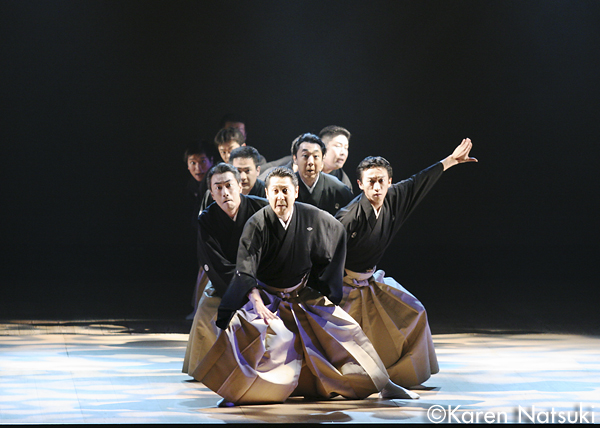
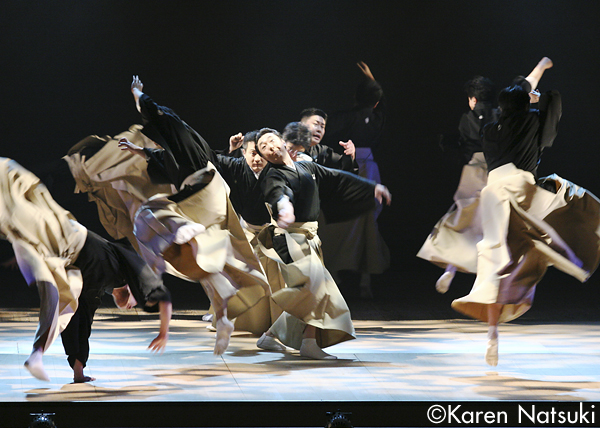
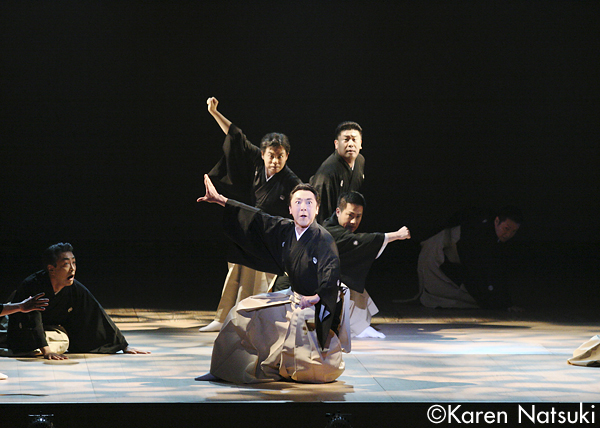
Onbashira
Premiere: 2000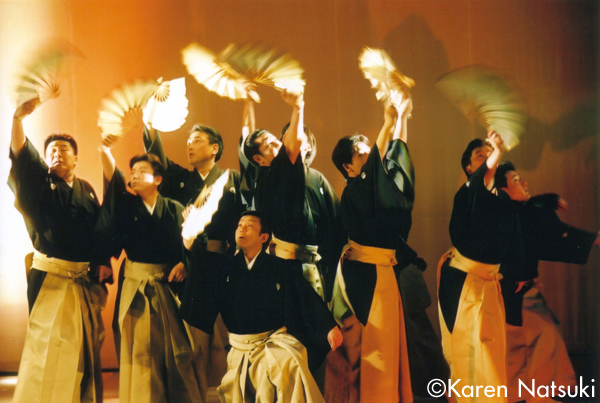
Otou Matsuri
Premiere: 2002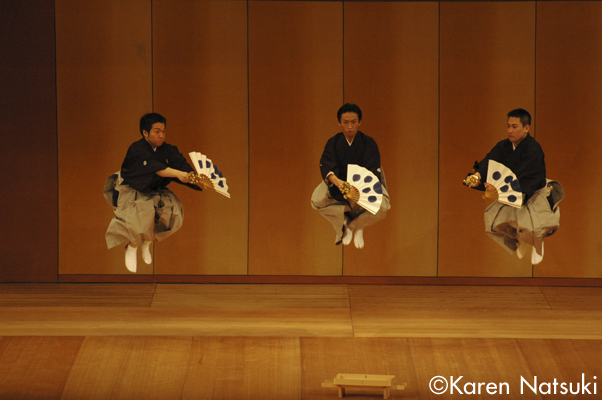
Hajime-shiki
Premiere: 2002
Ko (Arc)
Premiere: 2008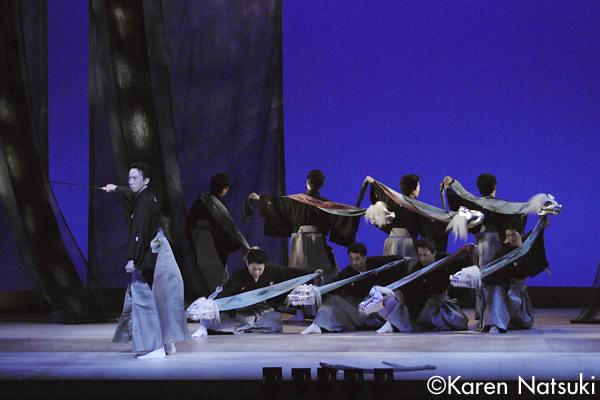
Orochi (Mythical eight-headed serpent)
Premiere: 2008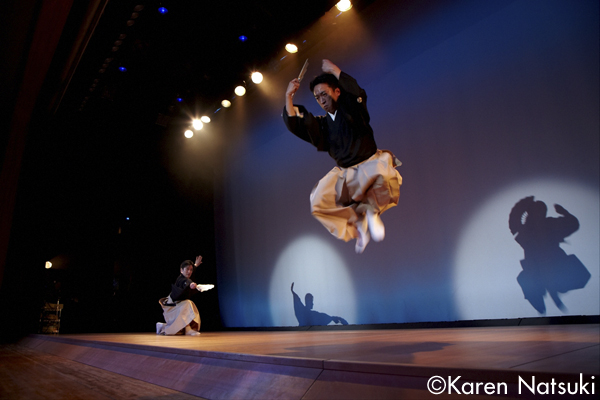
Ryuko (Tiger and Dragon)
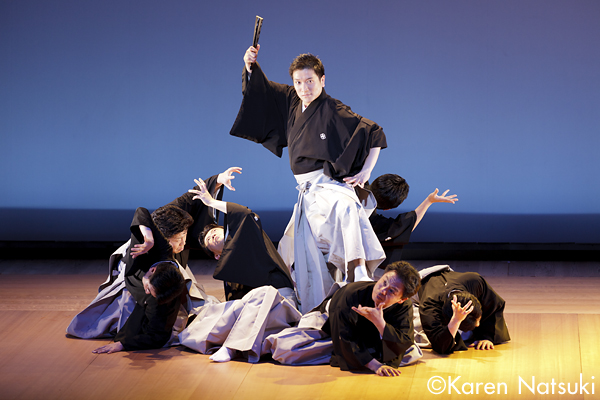
Bishamon
Premiere: 2011
Shosen Ichiyama
The Konokai group of Nihon Buyo artists, seeking new forms of Traditional Japanese Dance
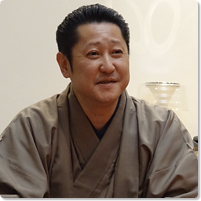
Shosen Ichiyama
Born in Tokyo in 1967. He studied under his father, Sho-oh Ichiyama. His first stage performance was at the age of two years and seven months, dancing a role Isamihada Kanda Matsuri at the Shimbashi Enbu-jo theater in Tokyo. In 1999, he joined with 12 Nihon Buyo family heirs of his own generation to form Konokai and become its representative. In 2004, he inherited the artist’s name of Shosen Ichiyama. He is the 2003 winner of the Hanayagi Ju-oh New Artist Award. In 2005, he was recipient of the Minister of Education, Culture, Sports, Science and Technology Gejutsu Sensho New Artist Award. He is a member of the Nihon Buyo Association.
Konokai website
http://www.konokai.com/
Interviewer: Kazumi Narabe, journalist
Konokai photos by Karen Natsuki
Related Tags

